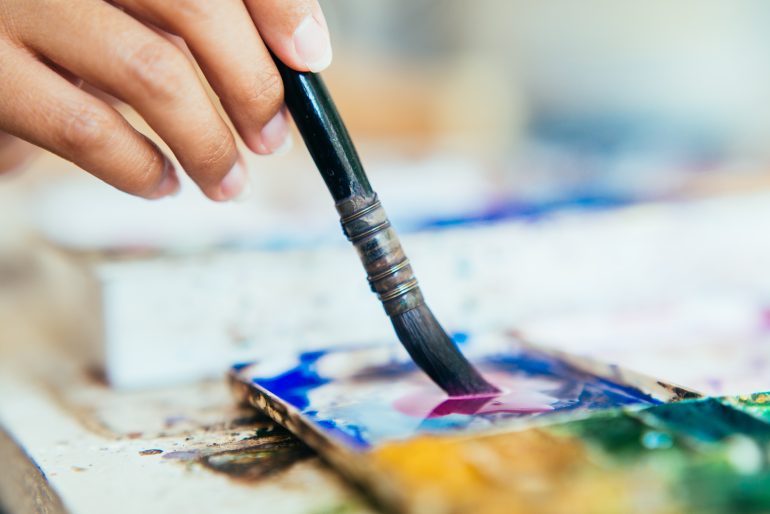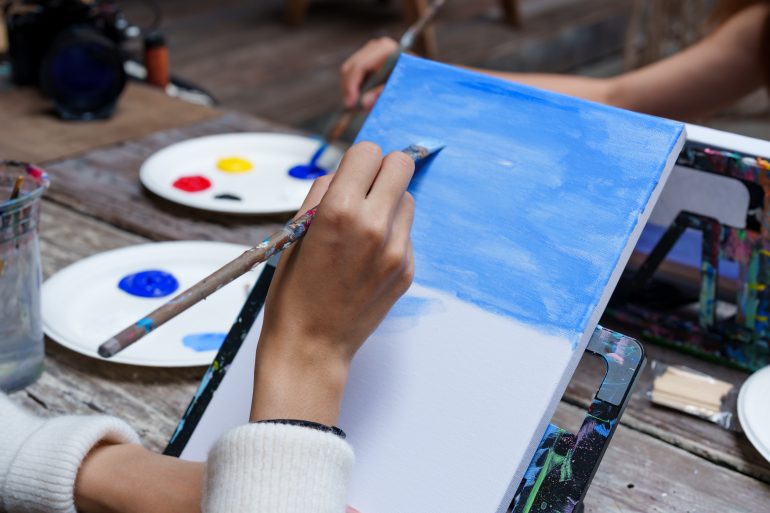Watercolour painting for beginners, like any skill, begins with understanding the basics. This introductory guide will provide you with an enlightening pathway into the wonderful world of watercolour.
Contrary to its seemingly elusive nature, watercolour is very forgiving and endlessly rewarding for those willing to embrace it. Whether you’re a seasoned artist transitioning from another medium or someone sketching out their first strokes searching for easy watercolour ideas, we’ll delve into the essential supplies every beginner needs, foundational techniques to get you started, and tips to demystify this enchanting medium.
Because, as you will soon discover, the joy of watercolour lies not just in the final masterpiece but in the creation itself.
A Concise History of Watercolour Painting

A close up of a watercolour brush being dipped in watercolour paint. (Credit: Guido Mieth via Getty Images)
The primitive predecessors to watercolour painting have been popular for thousands of years, ever since humans applied a mix of oche and charcoal to cave walls. It’s been used to illustrate manuscripts since Ancient Egyptian times and was prominent in the European Middle Ages, but watercolour painting came into its own during the Renaissance.
Many European artists used the watercolour technique, but perhaps the most famous of the early works is Young Hare by Albrecht Dürer from 1502. Later, English artists such as William Blake, Thomas Gainsborough and J. M. W. Turner embraced watercolour painting, and through Europe and the US, artists such as Eugene Delacroix, Paul Cezanne, Wassily Kandinsky, Paul Klee and John Singer Sargeant were famed watercolourists.
What You Need to Get Started with Watercolour

Watercolour palette with multi colour paints and brush on white background. (Credit: by Ruhey via Getty Images)
Watercolour painting for beginners doesn’t require too much in the way of equipment to get started but there is a short list of things you’ll need.
Paint
In craft and hobby shops or online, the price of paints – usually in 12 or 24 colour sets – is generally based on the amount of pigment. The more pigment in the paint, the more expensive it tends to be. There are two main grades of paint – student’s and artist’s. A student’s set usually hits the sweet spot between quality and value for money but it’s largely dependent on your budget.
Brushes
When you’re looking at beginner friendly watercolour ideas, the choice of brushes is all-important. Brushes vary quite dramatically in shape, size and materials so it’s a good idea to do some research before you decide on a set to buy.
Paper
There are three main textures of watercolour paper. Hot Press is completely smooth and allows for fine lines and intricate detail. Cold Press is slightly textured with an irregular, dimpled feel and is the most common choice for beginners. Rough Paper has a pronounced texture which lends itself well to creating textured effects and granulation.
As you progress, you may wish to invest in a set of artists pencils, an easel and other equipment, but for now, paint, brushes and paper is all you need to start your watercolour journey!
Watercolour for Beginners - Basic Ways to Paint

A close up of a girl painting a wet-on-dry watercolour painting. (Credit: Ekkasit Jokthong via Getty Images)
There are two main methods used in watercolour painting – wet-on-wet and wet-on-dry. There are many other techniques such as glazing, lifting and salt technique, but these are the foundational ones to get started.
Wet-on-Wet
This involves applying paint to pre-moistened paper, allowing colours to blend and flow organically. The process results in soft edges and is ideal for gradients and atmospheric effects. Success hinges on managing the water-to-paint ratio, providing a balance between control and spontaneity.
Wet-on-Dry
Wet-on-dry means applying wet paint to dry paper, producing clear and defined edges. This method gives artists precise control over brush strokes and colour placement. It’s suited for detailed work, layering, and achieving depth, moving from broad strokes to fine details.
Five Watercolour Painting Ideas for Beginners

A seascape and sunset watercoloir painting. (Credit: kampee patisena via Getty Images)
You have a blank canvas to do whatever you like but here’s a handful of beginner friendly watercolour ideas to get you started.
Abstract Designs
To get the feel of the brush on the paper, play around with abstract ideas including straight lines, geometric patterns and shapes, wavy lines, circles, diagonal lines and dots.
Sunsets
Using the traditional reds, oranges and yellows, painting sunsets is one of the easy watercolour ideas as it gives you practise using gradient techniques. You can also practise painting different times of the day and various cloud formations. This will help you with blending and lifting techniques.
Monochrome
Using different shades of a single colour will help you to understand light and dark, depth and colour intensity.
Fruit & Veg
Their organic shapes and varied colours make them excellent subjects. Try painting an apple, banana, or pepper and focus on capturing light, shadow, and texture.
Colour Charts
Make your own charts by mixing primary colours to see how they interact and what secondary colours they produce.
It’s important to remember that the process of learning watercolour for beginners is as valuable as the outcome. Every painting, whether deemed a success or failure, offers lessons and growth opportunities. The key is consistent practice and exploration.
Let the Journey Begin…

Watercolour circles (Credit: Yifei Fang via Getty Images)
The world of watercolour painting for beginners is as vast as it is enchanting, offering a unique blend of spontaneity, expressiveness, and depth. As with any art form, the journey into watercolours is one of continuous learning and exploration.
For beginners, it might seem awkward and unwieldy, but with time, patience, and practice, the technique becomes natural. This guide serves as your starting point, providing you with the foundational techniques and insights to set you on your path. But remember, the true magic of watercolour lies not just in mastering techniques but in the stories you’ll paint along the way.
Embrace the unpredictability, celebrate each brushstroke, and most importantly, enjoy the vibrant journey of watercolour painting!












